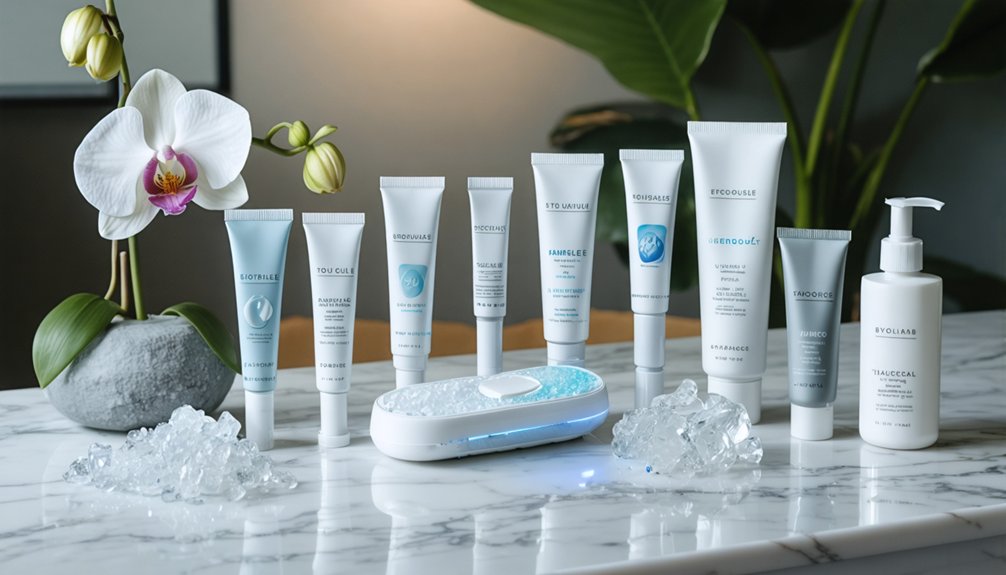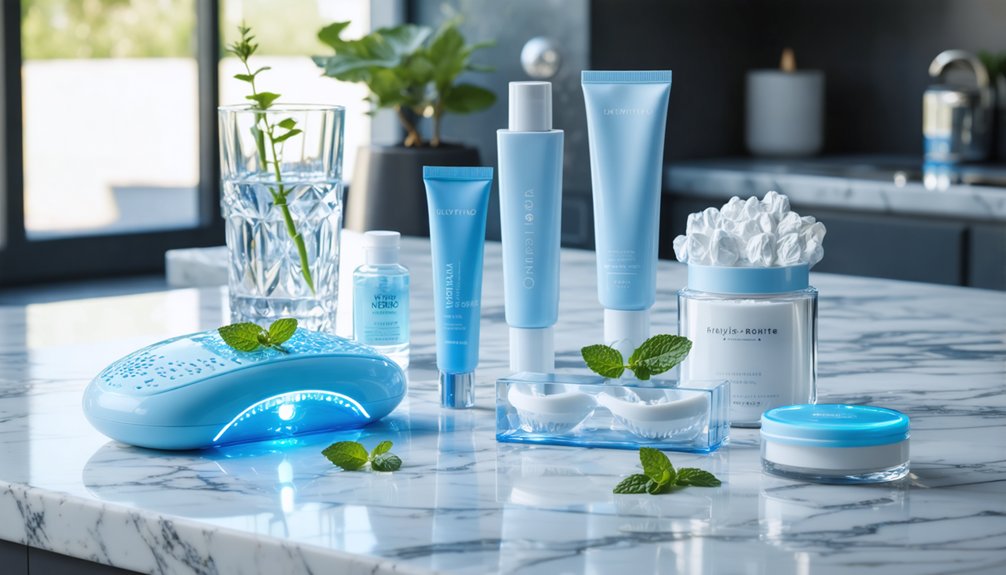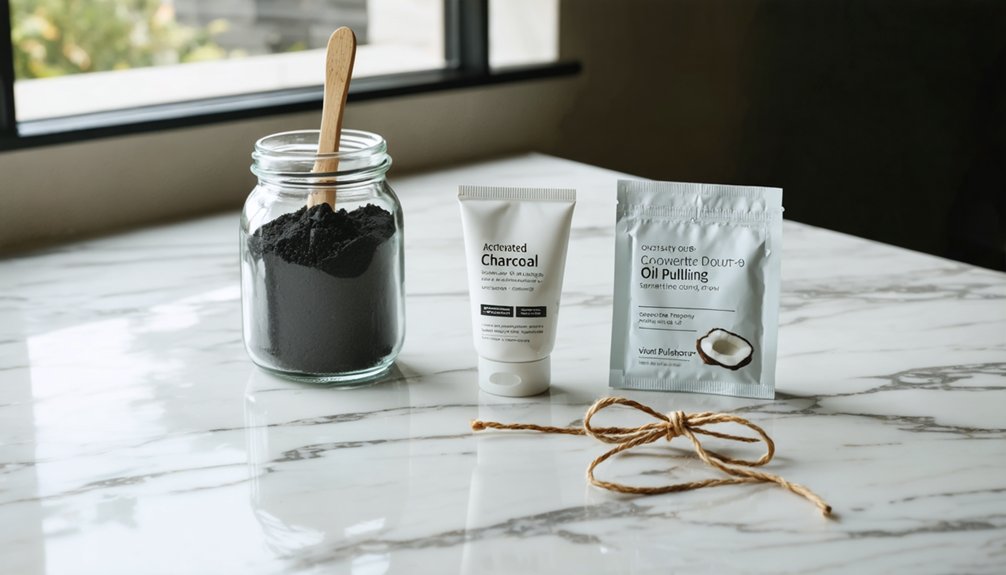You’ll find several effective whitening options for sensitive teeth, ranging from professional treatments to at-home solutions. Professional Zoom whitening offers controlled, supervised brightening, while custom-fitted trays provide gentler daily treatment. Sensitivity-safe strips, low-concentration pens, and PAP-based products deliver peroxide-free alternatives. Natural methods like oil pulling and specialized toothpastes can also brighten safely. Desensitizing pre-treatments and gradual approaches help guarantee peak comfort and results. Understanding each option’s unique benefits will guide your choice for the perfect whitening solution.
Key Takeaways
- Custom-fitted take-home whitening trays offer gentle, controlled whitening with lower-concentration gels specifically formulated for sensitive teeth.
- Peroxide-free PAP whitening products provide effective stain removal without causing sensitivity while protecting enamel with calcium and hydroxyapatite.
- Professional Zoom whitening treatments under dental supervision offer quick results with specialized desensitizing formulas to minimize discomfort.
- Gentle whitening strips with built-in desensitizers like potassium nitrate achieve 4-9 shades improvement while maintaining comfort.
- Low-concentration peroxide whitening pens (10% or less) combined with soothing botanicals provide targeted treatment for sensitive teeth.
Professional Zoom Whitening Treatment
While many teeth whitening options exist, Zoom whitening stands out as a highly effective in-office treatment that uses hydrogen peroxide gel activated by specialized LED or blue light technology.
During your 45-minute procedure, you’ll receive three to four 15-minute sessions where the light accelerates peroxide breakdown to penetrate and whiten your teeth up to 8 shades brighter. A dedicated dental care team supervises every step of the treatment to ensure optimal results.
Before beginning, your dentist will perform a sensitivity assessment to verify you’re a suitable candidate. A comprehensive exam of your teeth and gums must be completed before any whitening treatment can begin. They’ll clean your teeth and protect your gums before applying the gel.
If you have sensitive teeth, don’t worry – your dentist can apply fluoride gel afterward to minimize discomfort.
The procedure’s results typically last several months to over a year, and you’ll receive a take-home kit for touch-ups to maintain your brighter smile.
Custom-Fitted Take-Home Whitening Trays
For patients with sensitive teeth, custom-fitted take-home whitening trays offer a gentler alternative to intensive in-office treatments. The professional care and guidance helps ensure optimal results with minimal sensitivity.
You’ll receive professionally molded trays that fit precisely to your teeth, ensuring even gel distribution while minimizing gum exposure. Your dentist will prescribe lower-concentration gels specifically formulated for sensitive teeth. The controlled gel concentration allows your dentist to adjust treatment based on your sensitivity level.
These custom trays allow you to whiten at your own pace, typically wearing them for just 15-30 minutes daily.
Take control of your teeth whitening journey with gentle, daily treatments of 15-30 minutes using custom-fitted trays.
Proper gel application techniques are essential – you’ll learn to apply small dots of gel to each tooth impression while avoiding overflow. Your dentist will monitor your progress and adjust treatment as needed.
With proper tray maintenance tips, including thorough cleaning and safe storage, you can continue touch-up treatments at home while maintaining professional oversight of your whitening journey.
Gentle Whitening Strips With Built-In Desensitizers
Today’s gentle whitening strips feature built-in desensitizing agents like potassium nitrate and fluoride that protect your teeth while effectively removing stains.
You’ll find these strips offer a more comfortable whitening experience compared to traditional peroxide-only formulations, typically achieving 4-9 shades of improvement over a 7-14 day period. Daily use for consistency is essential to achieve optimal whitening results.
For ideal results, you should dry your teeth thoroughly before application and guarantee proper strip placement against your dental surfaces. Non-peroxide strips demonstrated significantly higher satisfaction among users while delivering comparable whitening results to peroxide-based options.
Desensitizing Strip Features
As dental technology has evolved, desensitizing whitening strips now incorporate specialized features to minimize tooth sensitivity while achieving effective whitening results.
You’ll find strips containing gentle whitening agents like PAP, which offers a peroxide-free alternative while maintaining whitening effectiveness. Built-in desensitizing ingredients such as potassium nitrate and strontium chloride help protect your teeth during the whitening process. Following proper application time of 30 minutes, these strips provide controlled exposure to minimize sensitivity risks. The slip-free design ensures consistent contact with teeth throughout the treatment duration.
Many strips now feature lower peroxide concentrations and shorter application times to reduce discomfort.
Some products include enamel-strengthening compounds like xylitol and hydroxyapatite, which work to protect your teeth’s surface. When combined with moisturizing ingredients like glycerin, these features create a more comfortable whitening experience while still delivering the results you’re seeking for your patients’ smiles.
Easy Application Tips
Now that you understand the features of desensitizing strips, proper application technique becomes the key to maximizing their effectiveness. Start with clean, dry teeth to guarantee ideal adhesive contact and desensitizer effectiveness. Adjust your whitening frequency based on your sensitivity level, beginning with applications every other day to monitor your response. A single 30-minute treatment can produce significant color changes in tooth brightness. The strips only whiten the front six teeth, so maintain realistic expectations about overall results.
- Store strips in a cool, dry place to maintain their desensitizing compounds and adhesive properties.
- Apply desensitizing toothpaste before and after treatments to reinforce enamel protection.
- Avoid acidic foods and hot/cold beverages immediately following strip application.
Remember to place strips carefully to achieve even coverage and prevent gum irritation. This targeted approach guarantees maximum contact between the desensitizing agents and your tooth surfaces while minimizing discomfort throughout the whitening process.
Low-Concentration Peroxide Whitening Pens
Low-concentration peroxide whitening pens offer a gentle yet effective solution for individuals with sensitive teeth seeking to brighten their smile.
Whitening pens with low peroxide levels provide a milder approach to teeth whitening for those struggling with tooth sensitivity.
These pens typically contain around 10% peroxide or less, balancing whitening efficacy with sensitivity management. Many formulations incorporate soothing botanicals like lavender oil and honeysuckle to minimize discomfort during treatment.
You’ll find that proper application is essential for best results. Clean and dry your teeth thoroughly, then apply the gel in short vertical strokes while avoiding your gum line.
Most products require 30 minutes without eating or drinking afterward. For best results, follow the manufacturer’s recommended frequency – usually twice daily for 14 days or 1-2 times weekly.
If you experience severe sensitivity, discontinue use and consult your dentist.
Sensitivity-Safe Whitening Toothpastes
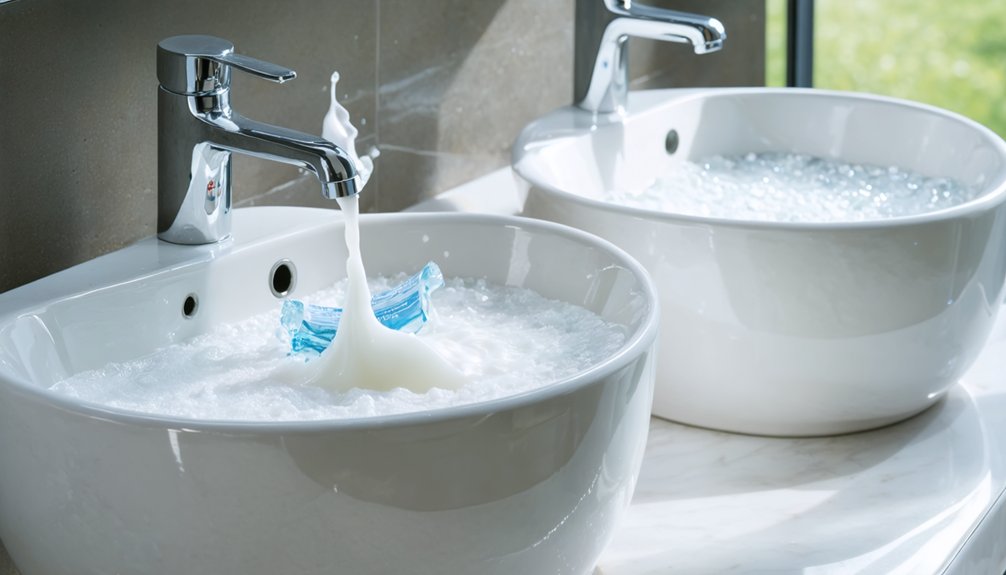
When selecting a whitening toothpaste for sensitive teeth, you’ll need formulations that contain specific desensitizing agents like potassium nitrate and strontium chloride.
These ingredients work by blocking nerve pathways and exposed dentin tubules, providing sensitivity reduction while you whiten. Look for products with low-abrasion formulas and enamel protection features like fluoride.
- Sensodyne Sensitivity & Gum Whitening builds a protective layer while gently removing stains and improving gum health
- Arm & Hammer Sensitive combines baking soda with 5% potassium nitrate for maximum relief
- Tom’s of Maine Simply White offers natural ingredients with silica for gentle whitening
Many sensitivity-safe whitening toothpastes now feature dual-action benefits, simultaneously brightening your smile while strengthening enamel and calming nerve sensitivity through specialized desensitizing agents.
Laser-Activated Professional Whitening
For those seeking faster, more dramatic whitening results, laser-activated professional treatments represent the most advanced option available for sensitive teeth.
Utilizing cutting-edge laser technology, these treatments can lighten your teeth up to 10 shades in just one visit while carefully managing sensitivity concerns.
Advanced laser treatments deliver dramatic whitening results – up to 10 shades brighter – in a single session while protecting sensitive teeth.
The whitening efficacy stems from the precise application of specialized lasers that activate high-concentration peroxide gels exclusively on your teeth’s surface.
Your dentist will protect your gums with barriers and can customize the treatment intensity based on your sensitivity level.
While you may experience temporary sensitivity, immediate post-treatment desensitizing formulas help minimize discomfort.
The procedure’s controlled nature, professional supervision, and ability to target deep stains make it particularly suitable if you’ve found other whitening methods too harsh on your sensitive teeth.
Natural Whitening Methods for Sensitive Teeth
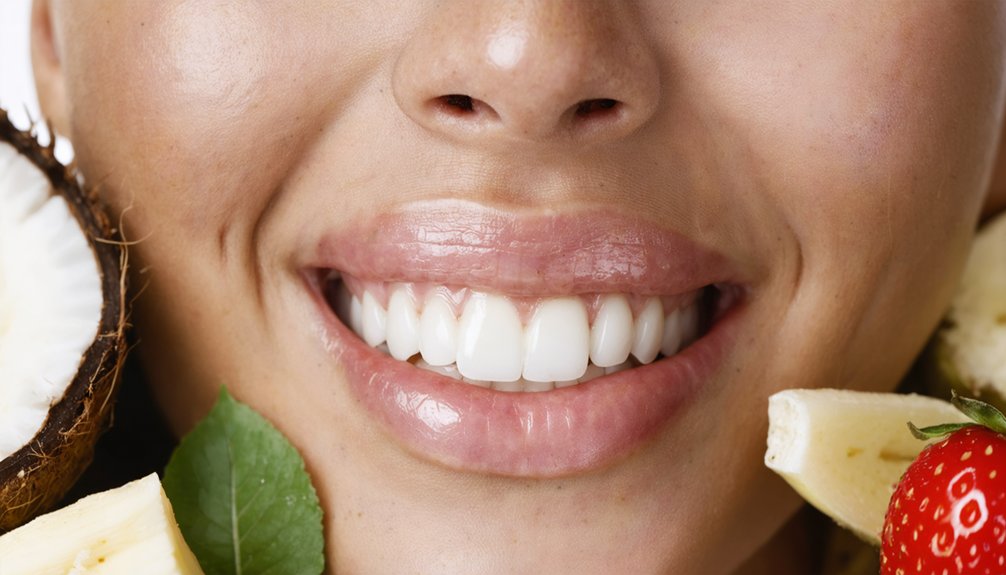
Natural whitening methods offer gentler alternatives for those with sensitive teeth who want to avoid harsh chemical treatments.
When considering these approaches, you’ll find several research-backed options that can help brighten your smile while protecting your sensitive enamel.
- Oil pulling benefits include bacterial reduction and potential plaque removal, with coconut oil emerging as the preferred choice due to its antimicrobial properties and pleasant taste.
- Important baking soda precautions: limit use to occasional applications and avoid vigorous brushing to prevent enamel damage.
- Dietary modifications can greatly impact tooth color – increase consumption of fibrous fruits and vegetables while reducing intake of staining beverages like coffee and wine.
For best results, combine these natural methods with proper oral hygiene and consider consulting your dentist before starting any new whitening routine.
Desensitizing Pre-Treatment Options
Before undertaking any teeth whitening procedure, proper desensitization can greatly reduce discomfort and improve treatment outcomes.
Pre-treatment protocols typically begin 1-2 weeks before whitening and involve daily use of specialized toothpaste containing potassium nitrate or fluoride to strengthen your enamel and shield nerve endings.
Your dentist may recommend professional pre-treatment options, including air-abrasion with desensitizing ingredients or GLUMA Desensitizer PowerGel application.
These in-office treatments don’t compromise whitening effectiveness but considerably reduce sensitivity.
You’ll need to maintain consistent use of prescribed products and avoid irritants like hot, cold, or acidic foods during the desensitization period.
Clinical studies confirm that patients who follow pre-treatment protocols experience less discomfort during whitening procedures, making this step essential for those with sensitive teeth.
Peroxide-Free PAP Whitening Products
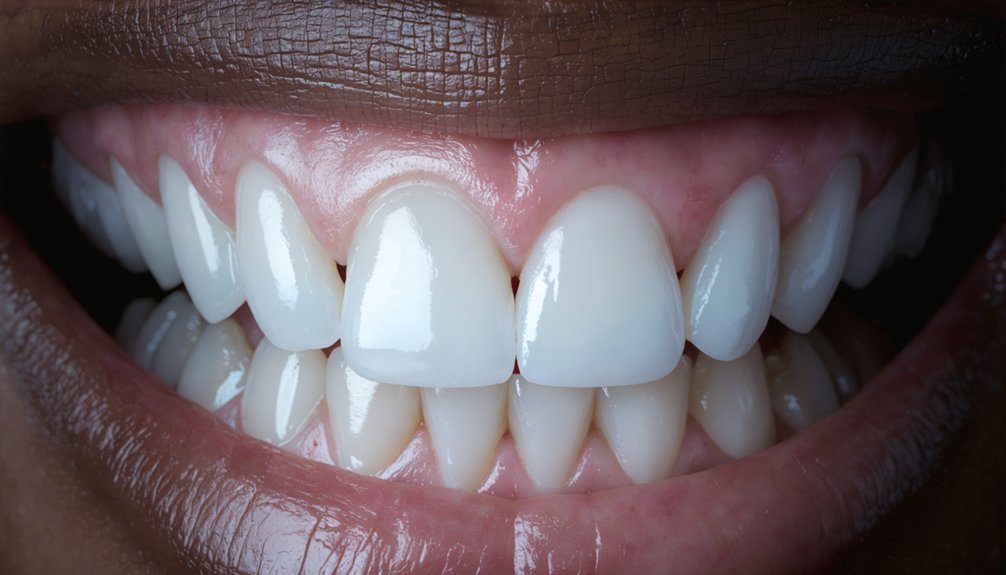
Looking for a gentler alternative to traditional peroxide whitening? PAP (Phthalimidoperoxycaproic Acid) offers powerful stain removal without compromising your enamel’s integrity. This innovative whitening agent neutralizes yellow discoloration using color theory while protecting your natural tooth structure.
PAP whitening technology delivers powerful stain removal without harsh peroxides, protecting your enamel while transforming your smile through advanced color science.
- Combines with ingredients like calcium, hydroxyapatite, and vitamin E for enhanced enamel protection and sensitivity reduction
- Achieves visible results within 1-2 weeks through gentle, 5-15 minute daily applications
- Works effectively on both surface and deep stains while being safe for dental work and restorations
You’ll find PAP in various product formulations, from dissolving strips to LED-activated gels, all designed for peak whitening efficacy and user experience. The peroxide-free formula means you won’t experience the tooth sensitivity commonly associated with traditional whitening methods.
Gradual At-Home Whitening Systems
When using custom whitening trays at home, you’ll need to guarantee proper fit and even gel distribution to maximize contact with tooth surfaces while minimizing gum exposure.
Your dentist can provide low-concentration whitening gels specifically formulated for sensitive teeth, typically containing 10-15% carbamide peroxide or less.
You’ll achieve best results by following your dentist’s recommended wear schedule, which may involve shorter daily sessions spread over several weeks rather than extended single treatments.
Custom Tray Application Tips
Proper application of custom whitening trays is essential for achieving excellent results while minimizing sensitivity and gum irritation. Before starting treatment, verify your trays fit correctly by testing them without gel. For best tray fitting, you’ll want to trim any excess material that might contact soft tissues.
When it comes to gel application, place a small dot (1-2mm) in each tooth well, focusing primarily on the front teeth while avoiding areas with dental work.
- Clean and dry your teeth thoroughly before each whitening session to maximize gel effectiveness
- Start with shorter wear times (30-60 minutes) and gradually increase duration based on sensitivity
- Store your trays in a cool, dry place and clean them gently with cold water after each use
Low-Concentration Gel Benefits
Low-concentration whitening gels offer a gentler approach to teeth whitening, particularly beneficial for patients with sensitive teeth.
These gels, typically containing 10-16% hydrogen peroxide or carbamide peroxide, gradually remove stains while maintaining enamel integrity. You’ll experience less tooth sensitivity compared to higher-concentration treatments because the peroxide exposure remains lower during each session.
Professional at-home kits provide safe, controlled application through custom-fitted trays or pre-filled options.
You can achieve significant whitening results over several weeks without risking the complications associated with stronger formulations. The extended treatment time actually works to your advantage, allowing for steady brightening while minimizing gum irritation and chemical burns.
For ongoing maintenance, these low concentration gels prove especially effective after previous in-office procedures.
Managing Treatment Time Windows
Successfully managing treatment time windows for gradual at-home whitening requires a strategic balance between effectiveness and comfort.
You’ll need to monitor sensitivity levels closely while following a consistent treatment schedule that allows adequate rest periods. Start with shorter daily applications of 5-30 minutes, gradually increasing duration as your teeth adjust to the treatment.
- Alternate between treatment days and rest days to minimize cumulative sensitivity and allow enamel remineralization.
- Reduce application time if you experience heightened sensitivity, making treatment adjustments based on your comfort level.
- Use sensitivity-specific oral care products before and after treatments to enhance your tolerance to whitening agents.
While gradual whitening takes longer to achieve desired results, this measured approach helps prevent sensitivity spikes and guarantees safer, more comfortable outcomes for those with sensitive teeth.
Frequently Asked Questions
How Long Should I Wait Between Different Whitening Treatments?
You’ll need to wait six months between professional whitening treatments and 48-72 hours between at-home sessions. Follow whitening frequency guidelines and treatment duration recommendations to protect your enamel.
Can I Whiten Teeth With Existing Dental Work Like Crowns?
Like oil and water, whitening methods don’t mix with dental crowns. You can’t whiten existing crowns, and whitening natural teeth may create color mismatches, requiring crown replacement to match your new shade.
Will Whitening Affect the Strength of My Tooth Enamel?
When used correctly, whitening chemicals cause minimal temporary changes to enamel strength, not permanent enamel erosion. You’ll need to follow product instructions carefully to protect your tooth structure.
Are There Certain Foods That Can Reduce Whitening Sensitivity?
You’ll find relief with sensitive foods like mild dairy products, bananas, and mashed potatoes. These natural remedies provide comfort while calcium-rich foods help strengthen your teeth during recovery.
What Medications Can Increase Tooth Sensitivity During Whitening Treatments?
While most medications don’t directly cause sensitivity, antihistamines and decongestants that reduce saliva can worsen whitening side effects by drying your mouth and making toothpaste ingredients less effective at protecting teeth.
References
- https://www.purpleplumdentistry.com/post/best-teeth-whitening-options-for-sensitive-teeth
- https://www.westriverdentalcare.com/best-teeth-whitener-for-sensitive-teeth/
- http://www.goochlanddentistry.com/whats-the-best-teeth-whitener-for-sensitive-teeth/
- https://buforddentist.com/what-are-the-best-whitening-options-for-sensitive-teeth/
- https://nhdentistrybeverlyhills.com/press/6-of-the-best-teeth-whitening-kits-in-the-drugstore/
- https://truesmileworks.com/which-teeth-whitening-method-is-best-for-sensitive-teeth/
- https://www.yourdentistryguide.com/zoom-whitening/
- https://smilesbyvivid.com/resources/zoom-teeth-whitening/
- https://www.banderdentalgroup.com/what-is-the-process-for-zoom-teeth-whitening/
- https://www.healthline.com/health/dental-and-oral-health/zoom-teeth-whitening
